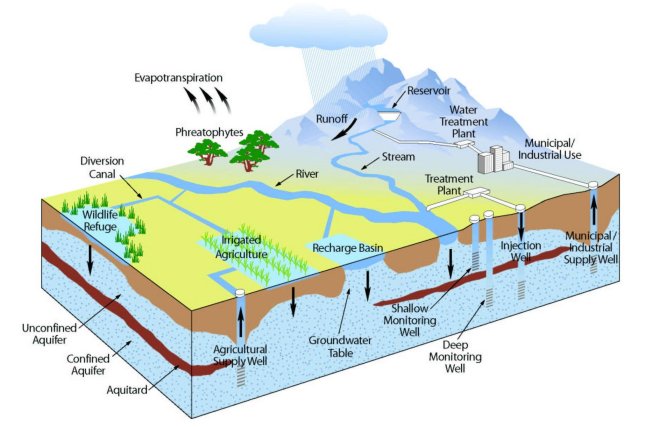

Today I have the pleasure to interview Dr. Evangelos Tziritis, a brilliant scientist and a friend. He will talk to us about Natural groundwater quality hazard and its implications. This blog aim is to discuss Natural Hazards. Therefore, today we will focus on the natural component of water quality, disregarding anthropogenic sources.
Evangelos is a Research Scientist at the Soil and Water Resources Institute of the Hellenic Agricultural Organization “Demeter”. His main research domain is focused on environmental hydrogeochemistry, as well as on other aspects including hydrogeology, aquifer vulnerability, geostatistics, isotope hydrology, water resources management, and environmental monitoring of water reserves. His record of achievements includes more than 10 years of experience in geo-environmental projects of basic and applied research in liaison with private firms, stakeholders, and academia. He has published more than 50 scientific papers in peer-reviewed journals and international conferences.
- Today we are going to talk about Natural Groundwater Quality Hazards. What can you tell us about it? How would you define the Natural Groundwater Quality Hazards?
Natural groundwater quality hazards are defined as the natural factors that adversely influence the environmental quality of aquifer systems. In contrast to anthropogenic factors which are purely man-induced (e.g. agricultural or industrial impacts, domestic sewage and wastes, seawater intrusion due to overexploitation, etc), the natural causes are triggered solely by geogenic factors, such as the weathering of geological formations; the impact of diagenetic processes; the influence of geothermal fields, etc.
Groundwater quality is dynamically affected by external (e.g. precipitation) and internal (e.g. lithology) factors, which may alter the initial, potentially pristine, chemical composition of the solution. Groundwater moving through rocks and soils may pick up a wide range of inorganic compounds including major and minor ions, heavy metals and metalloids, some of which are toxic in certain concentrations (e.g. Cadmium, Selenium, Arsenic, Copper, Boron, Lead, etc). It should be noted that natural hazards define along with other characteristics the hydrogeochemical background on an aquifer system, thus they are not related to contamination (defined as the deviation of the natural background values of a constitute) but rather to a relative enrichment of specific chemical constitutes, which depending on their overall concentrations and unique attributes (e.g. toxicity, bioavailability, etc) may be detrimental to natural and anthropogenic environment.
- What is the primary focus of your research and how does it relate to this topic?
My research is focused on the hydrogeochemistry of natural waters and how it affects their overall quality. Shortly, groundwater chemistry constitutes the cumulative effect of different factors and interactions between water solution and other spheres (geosphere, biosphere, atmosphere), which define the final groundwater composition. Identifying those factors and decoding the dominant processes that chiefly control chemical evolution is a major challenge and the key for sustainable groundwater resources management. Natural groundwater hazards is a critical component of this effort, due to the wide range of elements and sources of geogenic origin that have direct or indirect effects.
- Which are the tools to identify natural groundwater hazards and their affecting processes?
There are plenty of methods which can be used to identify the sources of natural groundwater hazards and the processes through which they affect groundwater quality. Methodologies vary from old-fashioned, yet effective methods, such as key molar ratios of groundwater constituents, diagrams and plots, and multivariate statistics. More advanced methodologies may include the use of isotopes (e.g. the use of δ53Cr values for the identification of natural Cr origin) and geochemical modeling with the use of large thermodynamic databases (e.g. PHREEQC). Recently, the scientific community has started to engage state of the art methods of Artificial Intelligence (e.g. Machine Learning) in order to explore the study and construction of algorithms that can learn from and make predictions on a given dataset (e.g. chemical analyses); thus, providing critical information about predictions and trends.
- Which are the most important parameters in terms of environmental quality? What processes involve their inclusion and concentration in water?
The most important parameters related to natural groundwater hazards depend on their potential impact to the natural and anthropogenic environment. As such, may be considered – but not limited to – some toxic heavy metals and metalloids (e.g. Cr, Pb, Cd, Ni, Co, As, Hg, Sb) which seriously affect ecosystem functioning and biota. The direct consumption of potable water which is enriched with those constituents or under circumstances the consumption of goods (e.g. fruits, vegetables, animals) which are irrigated and/or fed with waters of deteriorated quality, may have critical adverse effects to humans. The enrichment process, as already mentioned, are solely related to natural factors. The most common process is the weathering of volcanic and/or metamorphic geological formations, which are naturally enriched in heavy metals and metalloids. However, their dissolution and overall mobility depend on several factors, such as the available water content and flow regime; pH; redox conditions; complexation; sorption processes; microbial activity, etc.
- How can we minimize the impact of natural groundwater hazards? Are there a procedure in place to mitigate their effect both in the short and long terms?
Natural occurring groundwater hazards are difficult to be prevented. Their enrichment is a relative perpetual process in the human lifetime. Nevertheless, scientists and decision makers have nowadays the tools to timely identify those hazards, and make strategic decisions for groundwater quality management. Predictions and simulation models are also crucial in this planning, especially in the light of forthcoming inevitable adverse impacts, such as climate change. As a rule, prevention of a natural groundwater hazard, or at least increase of preparedness and resilience towards it, is always better than its remediation. However, even in the latter case, developed countries have the means (e.g. treatment processes, filters) to overcome or minimize the anticipated impacts; unfortunately, this is not always feasible for developing countries, which lack the resources to efficiently tackle with them.
